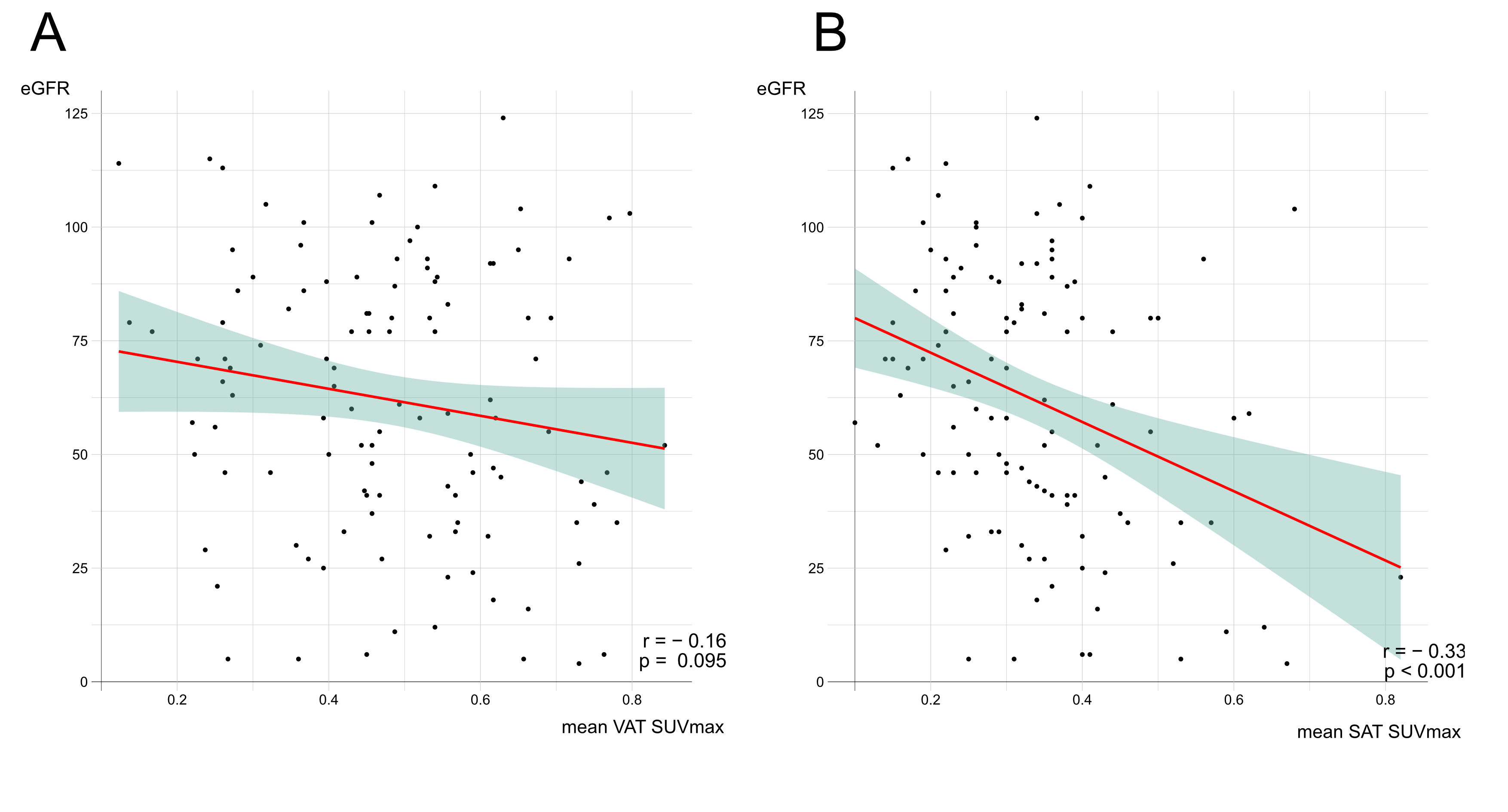Session Information
Date: Sunday, November 17, 2024
Title: Metabolic & Crystal Arthropathies – Basic & Clinical Science Poster II
Session Type: Poster Session B
Session Time: 10:30AM-12:30PM
Background/Purpose: Gout, a condition characterized by elevated uric acid levels, is linked to multiple complications, including coronary artery disease, hypertension, and type 2 diabetes mellitus. It is also associated with obesity and an increased risk of chronic kidney disease (CKD) progression. Recent research suggests a connection between adipose tissue and CKD progression, but the specific metabolic changes in adipose tissues in gout and their role in renal disease remain unclear. This study aims to evaluate the 18F-FDG standardized uptake value (SUV) by PET/CT in visceral adipose tissue (VAT) and subcutaneous adipose tissue (SAT) in patients with and without gout. Additionally, it seeks to determine whether glucose uptake-related metabolic activity in VAT and SAT predicts CKD worsening.
Methods: We used ICD-10 codes from the University of California San Diego (UCSD) patient database to identify patients with gout and controls, forming a cohort of individuals who underwent PET-CT scans. The mean VAT and SAT SUVmax were measured using 18F-FDG PET/CT and adjusted for potential confounders using inverse probability weighting (IPW) analysis. We also employed multivariable linear regression and Pearson correlation analysis to identify factors associated with increased SUV in patients with gout and to analyze changes in estimated glomerular filtration rate (eGFR) after PET imaging.
Results: The study included 221 patients, with 120 diagnosed with gout. The mean age of the cohort was 69.62 years (SD = 11.82), and 38.5% (n = 85) were female. After IPW, patient characteristics were well-balanced between the gout and non-gout patients. In the IPW adjustment, the mean VAT and SAT SUVmax were significantly higher in patients with gout (mean VAT SUVmax: β coefficient = 0.094, 95% CI = 0.039 to 0.148, p < 0.001; mean SAT SUVmax: β coefficient = 0.063, 95% CI = 0.008 to 0.118, p = 0.024) (Table 1). Multivariable linear regression revealed that stage 3 or higher CKD was associated with significantly higher mean VAT and SAT SUVmax in gout patients (mean VAT SUVmax: β coefficient = 0.067, 95% CI = 0.006 to 0.128, p < 0.05; mean SAT SUVmax: β coefficient = 0.068, 95% CI = 0.022 to 0.115, p < 0.05). eGFR inversely correlated with mean VAT and SAT SUVmax in gout patients, although the correlation with VAT SUVmax was not significant (mean VAT SUVmax: r = −0.16, 95% CI = −0.33 to 0.03, p = 0.095; mean SAT SUVmax: r = −0.33, 95% CI = −0.49 to −0.16, p < 0.001). (Figure 1) Additionally, in gout patients with CKD stage 3 or higher, higher mean VAT and SAT SUVmax were associated with a decrease of eGFR in five years post-18F-FDG PET/CT (mean VAT SUVmax: β coefficient = −0.90, 95% CI = −2.28 to 0.47; mean SAT SUVmax: β coefficient = −1.90, 95% CI = −3.62 to −0.18) (Table 2).
Conclusion: The study found that glucose uptake-associated metabolic activity in visceral and subcutaneous adipose tissue is elevated in gout patients. This increased metabolic activity may be related to the severity and progression of CKD among patients with both gout and CKD, highlighting a potential pathophysiological link that warrants further investigation.
To cite this abstract in AMA style:
Kaneshita S, Fukui S, Niku S, LEE K, Belezzuoli E, Terkeltaub R, Guma M. Chronic Kidney Disease Is Associated with Increased Glucose Uptake-associated Metabolic Activity of Visceral Adipose and Subcutaneous Adipose Tissue in Gout Patients [abstract]. Arthritis Rheumatol. 2024; 76 (suppl 9). https://acrabstracts.org/abstract/chronic-kidney-disease-is-associated-with-increased-glucose-uptake-associated-metabolic-activity-of-visceral-adipose-and-subcutaneous-adipose-tissue-in-gout-patients/. Accessed .« Back to ACR Convergence 2024
ACR Meeting Abstracts - https://acrabstracts.org/abstract/chronic-kidney-disease-is-associated-with-increased-glucose-uptake-associated-metabolic-activity-of-visceral-adipose-and-subcutaneous-adipose-tissue-in-gout-patients/



